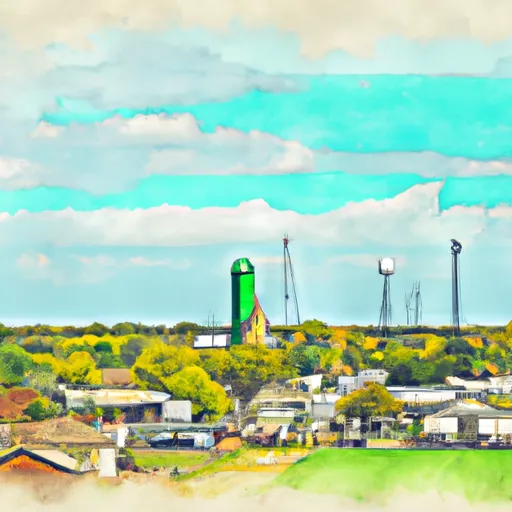-
 Snoflo Premium
Snoflo Premium
Get unlimited access to all our content
With no Ad interruptions! - Start Your Free Trial Login with existing account
Templeton
Eden Index
Climate
8.0
•
Recreation
2.5
•
Community
•
Safeguard
4.1/10

Templeton, Indiana is a charming town located in the Midwestern region of the United States. Known for its picturesque landscapes and friendly community, Templeton experiences a moderate climate throughout the year. Summers are warm and humid, with average temperatures ranging from 70°F to 85°F, while winters are cold with temperatures averaging around 20°F to 35°F. The town receives an average annual precipitation of 40 inches, which is evenly distributed throughout the year, providing ample water resources for outdoor activities.
In terms of hydrology, Templeton is blessed with several small rivers and streams that flow through the area, contributing to its natural beauty. These water bodies offer opportunities for fishing, kayaking, and canoeing, allowing residents and visitors to explore the serene waterways and indulge in recreational activities.
Outdoor enthusiasts will find plenty of opportunities to immerse themselves in nature in and around Templeton. The town boasts several parks and nature reserves that offer hiking trails, picnic areas, and camping facilities. The nearby forests provide a great setting for birdwatching and wildlife spotting. Templeton also hosts seasonal events like outdoor concerts and festivals, attracting visitors from neighboring towns.
In summary, Templeton, Indiana offers a moderate climate, abundant water resources, and various outdoor recreation opportunities. Whether it's enjoying the tranquility of the rivers, exploring nature trails, or participating in community events, Templeton has something to offer for everyone seeking an escape into the great outdoors.
What is the Eden Index?
The Snoflo Eden Index serves as a comprehensive rating system for regions, evaluating their desirability through a holistic assessment of climate health, outdoor recreation opportunities, and natural disaster risk, acknowledging the profound impact of these factors on livability and well-being.
Climate Health Indicator (CHI): 8.0
Templeton receives approximately
975mm of rain per year,
with humidity levels near 81%
and air temperatures averaging around
11°C.
Templeton has a plant hardyness factor of
5, meaning
plants and agriculture in this region thrive during a short period during spring and early summer. Most
plants will die off during the colder winter months.
By considering the ideal temperature range, reliable water supplies, clean air, and stable seasonal rain or snowpacks, the Climate Health Indicator (CHI) underscores the significance of a healthy climate as the foundation for quality living.
A healthy climate is paramount for ensuring a high quality of life and livability in a region, fostering both physical well-being and environmental harmony. This can be characterized by ideal temperatures, reliable access to water supplies, clean air, and consistent seasonal rain or snowpacks.
Weather Forecast
Streamflow Conditions
Wabash
Area Rivers
Wabash
Snowpack Depths
Wabash
Reservoir Storage Capacity
Wabash
Groundwater Levels
Recreational Opportunity Index (ROI): 2.5
The Recreational Opportunity Index (ROI) recognizes the value of outdoor recreational options, such as parks, hiking trails, camping sites, and fishing spots, while acknowledging that climate plays a pivotal role in ensuring the comfort and consistency of these experiences.
Access to outdoor recreational opportunities, encompassing activities such as parks, hiking, camping, and fishing, is crucial for overall well-being, and the climate plays a pivotal role in enabling and enhancing these experiences, ensuring that individuals can engage in nature-based activities comfortably and consistently.
Camping Areas
| Campground | Campsites | Reservations | Toilets | Showers | Elevation |
|---|---|---|---|---|---|
| Montgomery Bell State Park | 80 | 618 ft | |||
| Sullivan County Park | 450 | 520 ft | |||
| Prides Creek Co Park | None | 485 ft | |||
| Glendale State Fish and Wildlife Area | 120 | 495 ft | |||
| Montgomery Rec Park | None | 515 ft | |||
| Pike State Forest | 25 | 520 ft | |||
| Sunset City Park | None | 548 ft | |||
| Harpeth River Bridge | None | 393 ft | |||
| Greene - Sullivan State Forest | None | 521 ft | |||
| Res 26 - Greene - Sullivan State Forest | 25 | 498 ft |
Nearby Ski Areas
Catastrophe Safeguard Index (CSI):
The Catastrophe Safeguard Index (CSI) recognizes that natural disaster risk, encompassing floods, fires, hurricanes, and tornadoes, can drastically affect safety and the overall appeal of an area.
The level of natural disaster risk in a region significantly affects safety and the overall livability, with climate change amplifying these risks by potentially increasing the frequency and intensity of events like floods, fires, hurricanes, and tornadoes, thereby posing substantial challenges to community resilience and well-being.
Community Resilience Indicator (CRI):
The Community Resilience Indicator (CRI) recognizes that education, healthcare, and socioeconomics are crucial to the well-being of a region. The CRI acknowledges the profound impact of these elements on residents' overall quality of life. By evaluating educational resources, healthcare accessibility, and economic inclusivity, the index captures the essential aspects that contribute to a thriving community, fostering resident satisfaction, equity, and social cohesion.

